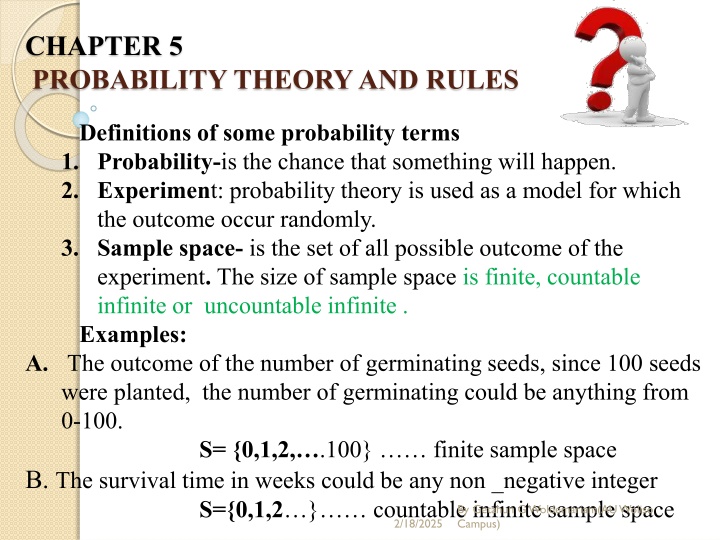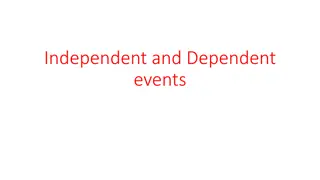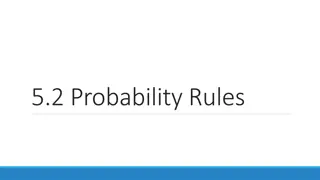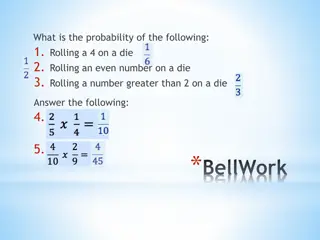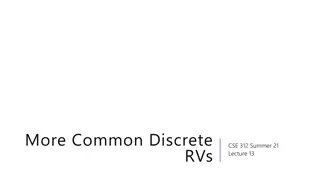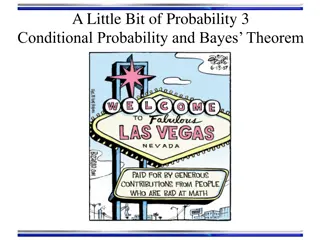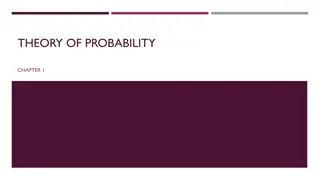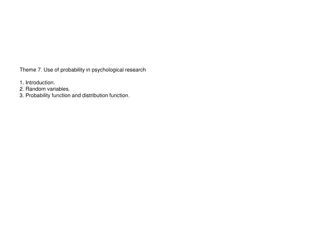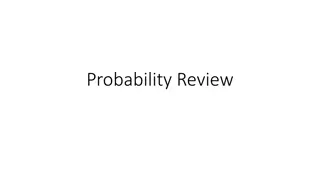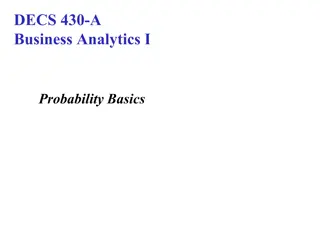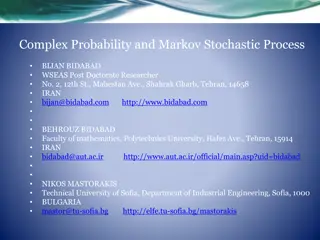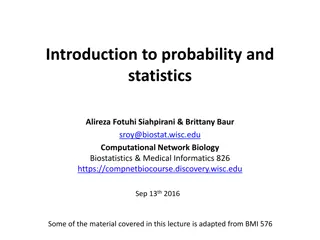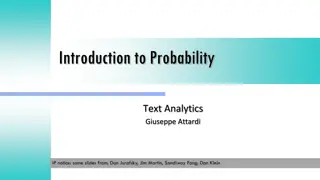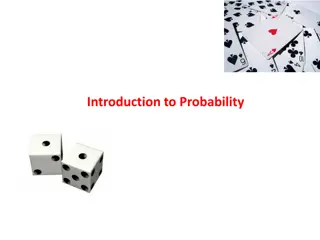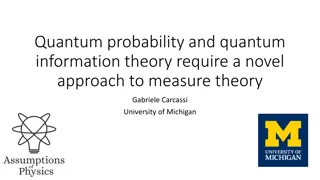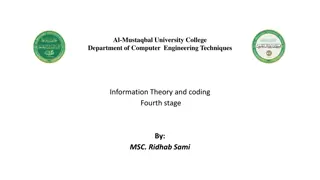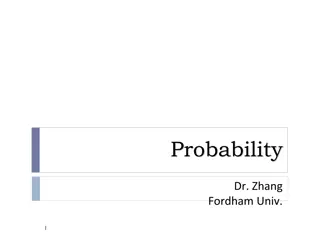Probability Theory Fundamentals - Definitions and Rules
Dive into the basics of probability theory with definitions of key terms like probability, experiment, sample space, outcome, event, and more. Understand the concepts of equally likely events, complementary events, elementary events, and independent events. Discover counting rules such as the addition rule, multiplication rule, permutation rule, and combination rule. Explore examples and scenarios to grasp the core principles of probability theory.
Download Presentation

Please find below an Image/Link to download the presentation.
The content on the website is provided AS IS for your information and personal use only. It may not be sold, licensed, or shared on other websites without obtaining consent from the author.If you encounter any issues during the download, it is possible that the publisher has removed the file from their server.
You are allowed to download the files provided on this website for personal or commercial use, subject to the condition that they are used lawfully. All files are the property of their respective owners.
The content on the website is provided AS IS for your information and personal use only. It may not be sold, licensed, or shared on other websites without obtaining consent from the author.
E N D
Presentation Transcript
CHAPTER 5 PROBABILITY THEORY AND RULES Definitions of some probability terms 1. Probability-is the chance that something will happen. 2. Experiment: probability theory is used as a model for which the outcome occur randomly. 3. Sample space- is the set of all possible outcome of the experiment. The size of sample space is finite, countable infinite or uncountable infinite . Examples: A. The outcome of the number of germinating seeds, since 100 seeds were planted, the number of germinating could be anything from 0-100. S= {0,1,2, .100} finite sample space B. The survival time in weeks could be any non _negative integer S={0,1,2 } countable infinite sample space By Getahun G Woldemariam(AU Woliso Campus) 2/18/2025
c. leaf size could be any positive real number S=R+ ={0,} uncountable infinite sample space 4. Outcome :The result of a single trial of a random experiment 5. Event: It is a subset of sample space. It is a statement about one or more outcomes of a random experiment .They are denoted by capital letters. There are 4 types of events A. Null events is the empty subset of the sample space. B. An atomic event- is a subset consisting of a single element of the sample space. C. A compound event- is a subset consisting more than one element of the sample space. D. The sample space itself is also an event. Example: Considering in a rolling of dice only one time, let A be the event of odd numbers, B be the event of even numbers, C be the event of number 8 and D the event of number 4. By Getahun G Woldemariam(AU Woliso Campus) 2/18/2025
6 , 4 , 2 = 5 , 3 , 1 A = = B C or empty space or impossible event Remark: If S (sample space) has n members then there are exactly 2n subsets or events. 6. Equally Likely Events: Events which have the same chance of occurring. 7. Complement of an Event: the complement of an event A means non-occurrence of A and is denoted by contains those points of the sample space which don t belong to A. 8.Elementary Event: an event having only a single element or sample point. 9. Mutually Exclusive Events: Two events which cannot happen at the same time. 10.Independent Events: Two events are independent if the occurrence of one does not affect the probability of the other occurring. ' c, , A or A or A By Getahun G Woldemariam(AU Woliso Campus) 2/18/2025
11. Dependent Events: Two events are dependent if the first event affects the outcome or occurrence of the second event in a way the probability is changed. Example: .What is the sample space for the following experiment A. Toss a die one time. B. Toss a coin two times. C. A light bulb is manufactured. It is tested for its life length by time. Solution a. S={1,2,3,4,5,6} b. S={(HH),(HT),(TH),(TT)} c. S={t /t 0} Sample space can be Countable ( finite or infinite) By Getahun G Woldemariam(AU Woliso Campus) 2/18/2025 Uncountable.
Counting Rules In order to calculate probabilities, we have to know The number of elements of an event The number of elements of the sample space. That is in order to judge what is probable, we have to know what is possible. In order to determine the number of outcomes, one can use several rules of counting. The addition rule The multiplication rule Permutation rule Combination rule THE ADDITION RULE : If E & F are two events which can occur simultaneously then the probability that either E or F will be occur is P(E) +P(F) The Multiplication Rule: If E & F are two independent events then the probability that both occur P(E)*P(F) By Getahun G Woldemariam(AU Woliso Campus) 2/18/2025
If a choice consists of k steps of which the first can be made in n1 ways, the second can be made in n2 ways, , the kth can be made in nk ways, then the whole choice can be made in Example: The digits 0, 1, 2, 3, and 4 are to be used in 4 digit identification card. How many different cards are possible if a) Repetitions are permitted. b) Repetitions are not permitted. Solutions A, 1st digit 2nd digit 3rd digit 4th digit ( * * ........ * ) . n n n ways 1 2 k 5 5 5 5 There are four steps 1. Selecting the 1st digit, this can be made in 5 ways. 2. Selecting the 2nd digit, this can be made in 5 ways. 3. Selecting the 3rd digit, this can be made in 5 ways. 4. Selecting the 4th digit, this can be made in 5 ways. = By Getahun G Woldemariam(AU Woliso Campus) 5 * 5 * 5 * 5 625 . different cards are possible 2/18/2025
B, 1st digit 2nd digit 3rd digit 4th digit 5 4 3 2 There are four steps 1. Selecting the 1st digit, this can be made in 5 ways. 2. Selecting the 2nd digit, this can be made in 4 ways. 3. Selecting the 3rd digit, this can be made in 3 ways. 4. Selecting the 4th digit, this can be made in 2 ways. = 5 * 4 * 3 * 2 120 . different cards are possible Permutation An arrangement of n objects in a specified order is called permutation of the objects. Permutation Rules: 1.The number of permutations of n distinct objects taken all together is n! Where ) 2 ( * ) 1 ( * ! = n n n n * ..... 2/18/2025 * 3 * 2 * 1 By Getahun G Woldemariam(AU Woliso Campus)
2. The arrangement of n objects in a specified order using r objects at a time is called the permutation of n objects taken r objects at a time. It is written as r and the formula is nP ! n nP = r ( )! n r 3. The number of permutations of n objects in which k1 are alike k2 are alike etc is n k k k * ... * !* 2 1 ! n = Example: 1.Suppose we have a letters A,B, C, D a. How many permutations are there taking all the four? b. How many permutations are there if two letters are used at time? 2.How many different permutations can be made from the letters in the word CORRECTION ? Solutions: 1. a) , 4 permutatio are There = = Here n there are four disnict object ! 4 24 . By Getahun G Woldemariam(AU Woliso Campus) ns 2/18/2025
= = b) , 4 2 Here n r ! 4 24 = = = 12 . There are P permutatio ns 4 2 4 ( 2 )! 2 2. = 10 Here n 2 k , 2 , 2 = 1 , k 1 , k = 1 , T 1 , I Of which = are = C are = O are R = E N = , 2 , 2 , 2 1 K k k k 1 2 rd 3 4 5 n 6 7 sin 3 , U g the rule of permutatio there are 10 ! = 453600 . permutatio ns 2 !* 2 !* 2 !* !* 1 !* 1 !* 1 ! 1 Combination A selection of objects with out regard to order is called combination. Example: Given the letters A, B, C, and D list the permutation& combination for selecting two letters. Solutions: Permutation Combination AB BC AB BA CA DA AC BD AC BC CB DB By Getahun G Woldemariam(AU Woliso Campus) AD DC AD BD CD DC 2/18/2025
Note that in permutation AB is different from BA. But in combination AB is the same as BA. CombinationRule The number of combinations of r objects selected from n objects is denoted by r Examples: 1. In how many ways a committee of 5 people is chosen out of 9 people? Solutions: n n ! n Cr or = and is given by the formula: n ( )!* ! r n r r = = 9 , 5 n r n ! ! 9 n = = = 126 ways ( )!* ! 4 !* ! 5 r n r r By Getahun G Woldemariam(AU Woliso Campus) 2/18/2025
2. Among 15 clocks there are two defectives .In how many ways can an inspector chose three of the clocks for inspection so that: a. There is no restriction. b. None of the defective clock is included. c. Only one of the defective clocks is included. Solutions:n=15 of which 2 are defective and 13 are non-defective; and r=3 A, If there is no restriction select three clocks from 15 clocks and this can be done in : = = 15 , 3 n r n ! 15 ! n = = = 455 ways ( )!* ! 12 !* ! 3 r n r r By Getahun G Woldemariam(AU Woliso Campus) 2/18/2025
B, None of the defective clocks is included. This is equivalent to zero defective and three non defective, which can be done in: 2 13 = * 286 . ways 0 3 C, Only one of the defective clocks is included. This is equivalent to one defective and two non defective, which can be done in: 13 * 1 2 = 156 . ways 2 By Getahun G Woldemariam(AU Woliso Campus) 2/18/2025
Approaches to measuring Probability There are 3 d/t conceptual approaches to the study of probability theory. These are: The classical approach. The frequenters approach. The subjective approach. The classical approach This approach is used when: .All outcomes are equally likely. Total number of outcome is finite, say N. Definition: If a random experiment with N equally likely outcomes is conducted and out of these NA outcomes are favorable to the event A, then the probability that event A occur denoted By Getahun G Woldemariam(AU Woliso Campus) (A ) P is defined as: 2/18/2025
. Total ( ) N No of outcomes favourable to A n A = = = A ( ) P A outcomes ( ) N number of n S Examples: 1.A fair die is tossed once. What is the probability of getting a. Number 4? b. An odd number? c. An even number? d. Number 8? Solutions: First identify the sample space, say S 6 , 5 , 4 , 3 , 2 , 1 = S n N = S = ( ) 6 A. Let A be the event of number 4 c) Let A be the event of even numbers 1 ) ( = = A n A P 6 , 4 , 2 = N A ( n = 4 A = A N n A = ) A 3 n A A ( ) = = ( ) 1 6 ( ) = = = ( ) By Getahun G Woldemariam(AU Woliso Campus) 3 6 5 . 0 P A ( ) n S ( ) n S 2/18/2025
B, Let A be the event of odd numbers d) Let A be the event of number 8 3 ) ( = = A n A P = 5 , 3 , 1 N A A = {} N A n A = = ( n ) A 0 n A A ( ) ( ) = = = ( ) 3 6 5 . 0 = = = ( ) 0 6 0 P A ( ) n S ( ) n S 2. A box of 80 candles consists of 30 defective and 50 non defective candles. If 10 of this candles are selected at random, what is the probability that a. All will be defective. b. 6 will be non defective c. All will be non defective 80 N selection Total = = A, Let A be the event that all will be defective. 50 * 10 = = S n Solutions: = ( ) n S 10 30 = = = ( ) Total way in which A occur N n A A 0 30 50 * 10 0 ( ) n A = ( ) 00001825 . 0 P A 80 ( ) By Getahun G Woldemariam(AU Woliso Campus) 2/18/2025 10
B, Let A be the event that 6 will be non defective. 30 50 = = = * ( ) Total way in which A occur N n A A 4 6 30 50 * 4 6 ( ) n A = = = ( ) . 0 265 P A 80 ( ) n S 10 C, Let A be the event that all will be non defective. 30 50 = = = * ( ) Total way in which A occur N n A A 0 10 30 50 * 0 10 ( ) n A = = = ( ) 00624 . 0 P A 80 ( ) n S 10 Short coming of the classical approach: This approach is not applicable when: The total number of outcomes is infinite. Outcomes are not equally likely. By Getahun G Woldemariam(AU Woliso Campus) 2/18/2025
The Frequentist Approach This is based on the relative frequencies of outcomes belonging to an event. Relative frequency, which is the ratio of the occurrence of a singular event and the total number of outcomes. Example: 1. find the relative frequency of the data set color frequency Relative frequency Purple 7 7/20 = 35% Blue 3 3/20 = 15% Pink 5 5/20 = 25% Orange 5 5/20 = 25% total 20 20/20 = 100% 2. If records show that 60 out of 100,000 bulbs produced are defective. What is the probability of a newly produced bulb to be defective? Solution: Let A be the event that the newly produced bulb is defective. 60 lim ) ( = = N N N = A 0006 . 0 P A 100 000 , By Getahun G Woldemariam(AU Woliso Campus) 2/18/2025
Subjective approach - this is type of probability based on the beliefs of the person making the probability assessment. Subjective probability assessment is often found when events occur only once or at most every few times. The disadvantages of subjective probability are that two or more person facing the same evidence / problem may arrive d/t probability. That is for the same problem there may be d/t decision. Conditional probability and Independency Conditional Events: If the occurrence of one event has an effect on the next occurrence of the other event then the two events are conditional or dependant events. Example: Suppose we have two red and three white balls in a bag 1.Draw a ball with replacement Since the first drawn ball is replaced for a second draw it doesn t affect the second draw. For this reason A and B are independent. Then if we let By Getahun G Woldemariam(AU Woliso Campus) 2/18/2025
2 = ( ) p A A= the event that the first draw is red 5 2 B= the event that the second draw is red = ( ) p B 5 2. Draw a ball with out replacement This is conditional b/c the first drawn ball is not to be replaced for a second draw in that it does affect the second draw. If we let A= the event that the first draw is red 2 = ( ) p A 5 B= the event that the second draw is red P(B) = 1/4 Conditional probability of an event The conditional probability of an event A given that B has already occurred, denoted by B ( ) p A B ( ) ( ) p A B p A B , ( ) 0 p B is = ( ) p By Getahun G Woldemariam(AU Woliso Campus) 2/18/2025
Remark: (1) ' ' = = ( ) 1 ( ) p B A p B A ( ) 1 ( ) p A B p A B (2) Examples 1. For a student enrolling at freshman at certain university the probability is 0.25 that he/she will get scholarship and 0.75 that he/she will graduate. If the probability is 0.2 that he/she will get scholarship and will also graduate. What is the probability that a student who get a scholarship graduate? Solution: Let A= the event that a student will get a scholarship B= the event that a student will graduate , 75 . 0 ) ( , 25 . 0 ) ( = = A B p quired ( ) = . 0 20 given p A p B p A B ( A ) Re ( ) . 0 20 p B ( ) = = = . 0 80 p B A ( ) A . 0 25 p 1. If the probability that a research project will be well planned is 0.60 and the probability that it will be well planned and well executed is 0.54, what is the probability that it will be well executed given that it is well planned? Solution; Let A= the event that a research project will be well Planned By Getahun G Woldemariam(AU Woliso Campus) 2/18/2025
B= the event that a research project will be well Executed 60 . 0 ) ( = A B p quired ( ) = , 54 . 0 given p A p A B ( A ) Re ( ) 54 . 0 p B ( ) = = = 90 . 0 p B A ( ) A 60 . 0 p Exercise: A lot consists of 20 defective and 80 non-defective items from which two items are chosen without replacement. Events A & B are defined as A = the first item chosen is defective , B = the second item chosen is defective a) What is the probability that both items are defective? b) What is the probability that the second item is defective? Note: for any two events A and B the following relation holds. ( ) ( ) ( ) . A p A B p B p = ( ) ( ) p Campus) '. By Getahun G Woldemariam(AU Woliso ' + p B 2/18/2025 A A
Probability of Independent Events Two events A and B are independent if and only if ( Here ( ) ( ) A p B A p = , ) ( ) ( ) p A . = p A B p B ( ) ( ) B = P B A p Example; A box contains four black and six white balls. What is the probability of getting two black balls in drawing one after the other under the following conditions? a) The first ball drawn is not replaced b) The first ball drawn is replaced Solution; Let A= first drawn ball is black Required ( B= second drawn is black ) B A p By Getahun G Woldemariam(AU Woliso Campus) 2/18/2025
( ( ) ) ( ) ( ) ( . A p )( ) = = = / 3 )( 9 4 ) 10 2 15 p A B p ( ) ( ) ( . p A p B A A, = = = B, 4 10 4 10 4 25 p A B B By Getahun G Woldemariam(AU Woliso Campus) 2/18/2025
